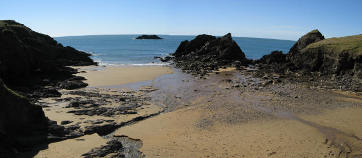2017
Plymouth in the Blitz -- Chris Robinson
A special request was made to the History Group for a talk about Plymouth in the Blitz and, following advice from Plymouth Museum, we were put in touch with a real expert – Chris Robinson, a local writer, broadcaster and historian.
Born in the city, Chris is a fount of knowledge about Plymouth and has an enormous collection of photographs showing how the city has changed over the years, some of which he has compiled into an interesting series of books. He showed us a selection of photos taken during WW2 and it was distressing to see the amount of damage that was inflicted on the city. It was a very interesting talk, with incredible visuals, and Chris peppered it with anecdotes and stories.
He has put his collection of wartime photographs to good use by re-publishing a book by Pat Twyford, It Came to our Door, an “evocative, eye-witness account of Plymouth during the war years”. The first editions of the book included very few photographs but now it has around four hundred illustrations, 90% of them new to the title and around half of them appearing in book form for the first time. It’s a fascinating book, as are Chris’s other titles – one of them would make a great Christmas present!
Kelly "Shiny Ore" Mine
At our April History Group meeting, Colin Vosper encouraged us to be “enthused and inspired” by his talk and we certainly were! Colin was telling us about Kelly ‘Shiny Ore’ Mine and he was such a good speaker that a subject that, in cold print, might have sounded rather boring, really came alive and gave us a taste of what a wonderful job the Kelly Mine Preservation Society is currently doing.
Kelly Mine is one of several Devon iron ore mines, situated on the eastern flank of Dartmoor near Lustleigh. The mine worked deposits of micaceous iron oxide, also known as MIO, micaceous haematite or 'shiny ore', which is a flaky form of iron oxide, Fe2O3, used mainly in the production of water-proof paint. Although a relatively small mine, it is of great significance today as an industrial heritage site. When the mine finally closed in 1951, the company then running the operation was in debt to the landowner for rent and for royalties on the ore extracted. In lieu of payment the company left the machinery on the site. More than thirty years later, in 1984, the owner agreed to lease the site to a group of mining enthusiasts, now the Kelly Mine Preservation Society, which is restoring and preserving this time capsule for future generations; the mine has been refurbished and the machinery and processing plant restored to working order.
Colin showed us some marvellous period photos of the mine, including miners with candles attached to their hard hats with clay and some rather Heath Robinson-ish wheelbarrows and carts. He had also brought along some of the sparkly ‘shiny ore’ to show us; apparently, tiny particles are very prone to attach themselves to your clothes and the miners used to go home looking as though they were covered with fairy dust! Colin also brought a lovely example of “Sparkleware” pottery, made in the “smallest pottery in England” in Ron Jackson’s garden shed.
Visitors are welcome at the mine on Wednesdays and Sundays and it’s free, with donations welcome.
After Colin Vosper’s fascinating introduction at our April meeting, a group of us visited the mine in June to see it all first hand – and we weren’t disappointed.
We were allowed to walk a few yards into one of the old horizontal mine shafts, which was lit by candles as it would have been originally, to see the sort of conditions the miners worked in. Our enthusiastic and knowledgeable guides, Nick and Richard, then took us on a walk around the site and explained the whole process from mining the ore to the dispatch of the final product from the drying shed. We were able to see the ore washing, jigging and stamping equipment, which is all in working order, as is other machinery in the mill. The settling tanks, waterwheels and the mine tramway, with its wagons and haulage winch, all added atmosphere to what is a leafy, tranquil site. We ended the visit with a look at their small museum and a display of artefacts from other mines in the area.
Devon Cob: A Living Tradition -- Linda Watson, Conservation Architect
Devon remains one of the richest counties in England for examples of cob building both new and old. We automatically assume that our old Devon thatched cottages are made of this mixture of subsoil, water, some kind of fibrous organic material (typically straw) and sometimes lime. However, there is a much wider range of cob buildings in the county, such as Regency villas in Dawlish and even a chapel in Collompton, and new innovations in cob building have helped to ensure that the tradition still thrives in our county.
Linda Watson, a conservation architect who has spent her working life in building conservation education and research and has lectured widely across Europe on Devon’s cob buildings, was kind enough to visit the History Group in February to tell us about this interesting and adaptable building material. Alongside the Devon examples, Linda showed us slides of earth buildings all over the world including some amazing adobe buildings in southern USA, South America and the Middle East.
It was a fascinating insight into this aspect of our county and Linda is an enthusiastic and very knowledgeable speaker. She encouraged those of us who wanted to find out more to visit the Devon Rural Archive in Shilstone or go onto their website where there are details of upcoming courses in caring for our historic buildings.
Previous reports

